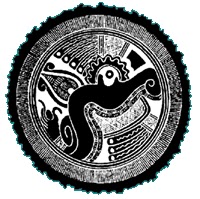This week, our team of Marlene Kroner, Lucas Betthausen, Soren Kraack, and Lorenzo Lopez conducted bird population monitoring by mist netting in Laguna de Apoyo Nature Reserve. Every month, we use mist netting to capture birds for a population monitoring longitudinal study. Here is a selection of the birds they caught in photos, followed by a list of all species captured during this period.
| Grey-headed Tanager (Eucometes penicillata). Photo by Soren Kraack. |
| Male Painted Bunting (Passerina ciris) having its plumage reviewed and noted in our data bank. Photo by Soren Kraack. |
| Stripe-throated Hermit (Phaethornis striigularis). Photo by Soren Kraack. |
There are at least ten species of hummingbirds found in the Tropical Dry Forest habitat of Laguna de Apoyo Nature Reserve. The Stripe-throated Hermit prefers more dense forest cover than others such as the Cinnamon Hummingbird which is more common at Estacion Biologica. This little bird may have co-evolved with specific flowers from which it feeds, hence the decurved bill. This species has recently been named as distinct from the Little Hermit (Phaethornis longuemareus) which now is limited to South America.
| Lesser Greenlet (Hylophylus decurtatus). Photo by Soren Kraack. |
The Tropical Dry Forest habitat abounds in flycatchers (Tyrannidae). Among the less flycatcher-like in behavior of this family is the smallish and retiring Yellow-olive Flycatcher (Tolmomyias sulphurescens). It makes a small pyriform nest with an entrance near the bottom. We often have nests in the yard at Estacion Biologica. The feathers at the top of this bird's head have been wettened by the handler to examine ossification of the cranium-a test for the bird's age.
| Red-eyed Vireo (Vireo olivaceus). Photo by Soren Kraack. |
Here is a list of the birds captured during the April mist netting. Notice how different this list is from the birdwatching list of the same date. It gives you an idea, too, of what you can see when birdwatching in Laguna de Apoyo Nature Reserve.
Catharus ustulatus
Thryothorus rufalbus
Hylocharis eliciae
Chiroxiphia linearis
Eucometis penicillata
Passerina ciris
Xiphorhynchus flavigaster
Turdus grayi
Vireo olivaceus
Chlorostilbon canivetii
Seiurus noveboracensis
Arremonops rufivirgatus
Vermivora peregrina
Basileuterus rufifrons
Myiarchus crinitus
Seiurus aurocapillus
Tolmomyias sulphurescens
Hylocichla mustelina
Thryothorus pleurostictus
Hylophilus decurtatus
Phaethornis striigularis
Dendroica pennsylvanica
Amazilia cyanura
Click on the "escudo" to contact us.

1 comment:
Love your website! I really enjoy the pictures and information on the birds. Also wanted to let you know that the picture above is of a Lesser Greenlet, not a Yellow-olive Flycatcher.
Stephen
Post a Comment